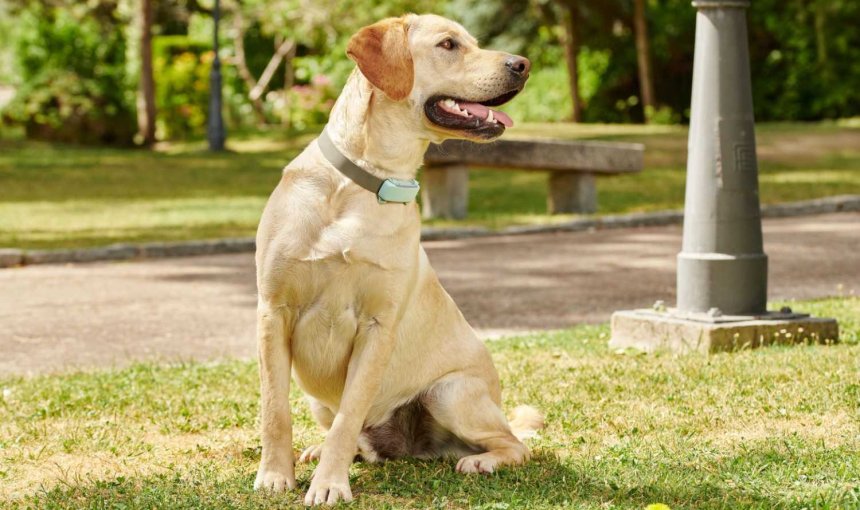 Approved by Dr. Dwight Alleyne, DVM
Approved by Dr. Dwight Alleyne, DVM Dog Breathing Fast? When It’s A Big Deal (And When It’s Not)
Here's what’s normal, when to see a vet & how to monitor their health with a GPS & Health Tracker.

You’re snuggled up on the couch with your pup when you notice it: your dog breathing fast. Maybe they’re resting, maybe they’re sound asleep – and suddenly you’re wondering, “Is this normal? Should I be worried?” Thankfully, you’re not alone. Many dog parents find themselves asking questions like:
- Why is my dog breathing fast?
- Why is my dog breathing so fast while sleeping?
- What’s the difference between fast breathing and panting anyway?
- And when to head to the vet?
Let’s take a deep breath together and explore what fast breathing in dogs actually means – what’s normal, what’s not, and how you can keep tabs on your furry friend’s health with a little tech help.
Key Takeaways
😴 Fast breathing in dogs can be normal – especially after exercise or during REM sleep. But it can also signal a health concern.
💊 Medical reasons for rapid breathing include heart disease, fever, lung issues, anemia, poisoning, or pain.
🚩Watch out for signs like blue (or pale) gums, lethargy, or breathing over 35 breaths per minute at rest. If you’re ever unsure, it’s best to talk to your vet and get a proper diagnosis.
🐶 A smart dog tracker with GPS & Health monitoring like Tractive can help you spot early changes in your dog’s breathing rate, so you can act fast if something’s off.

Always know your buddy is healthy & safe
Read more- What is normal dog breathing?
- Why is my dog breathing fast?
- Medical reasons your dog might be breathing fast
- Why is my dog breathing fast while sleeping?
- Dog breathing fast – but not panting?
- When to call your vet
- How your vet might diagnose & treat fast breathing in dogs
- How you can keep an eye on your dog’s health & wellbeing
- Bottom line: Stay calm, stay informed
What is normal dog breathing?
A healthy, relaxed adult dog typically takes between 15-30 breaths per minute. Puppies may breathe a bit faster, especially when excited. But if you’re seeing more than 30-35 breaths per minute while your dog is resting or sleeping, it might be time to pay closer attention.
📝 Try this: Count your dog’s breaths when they’re at rest. One inhale + one exhale = one breath. Do this for 30 seconds, then double it. That’s your dog’s resting respiratory rate.
Read more: Dog Breathing Weird? Here’s What Could Be Wrong
Why is my dog breathing fast?
There are a bunch of reasons your dog could be breathing fast – and not all of them are cause for concern. Here’s a breakdown:
- Dreaming & REM sleep
If your dog is breathing fast while sleeping but otherwise seems healthy, they might just be deep in dreamland. During REM sleep, dogs often twitch, whimper, move their paws, and yes – breathe faster. It’s totally normal. - Heat or physical activity
Just back from a walk? Fast breathing might just be their way of catching their breath. Dogs don’t sweat like we do – they cool down by breathing faster or panting. - Stress, excitement, or anxiety
Has something changed in your home? A loud noise, a vet visit, or even a new house guest can spike your dog’s stress levels. Fast breathing can be their way of reacting to that.
💡A smart dog tracker like Tractive can help you monitor your dog’s vital signs – including their breathing rate. If your dog’s breathing seems elevated, you’ll find out quicker via the app.

Get health alerts for your dog
Our pups can’t always tell us if something’s wrong. But if their tracker detects unusual changes in their routine, you’ll get an alert, helping you catch potential issues early.
Medical reasons your dog might be breathing fast
- Pain or injury
Dogs often mask pain, but fast, shallow breathing may be a clue something hurts. - Fever or infection
Infections or fevers increase the body’s demand for oxygen, speeding up breathing. - Heart disease
Conditions like congestive heart failure can cause fluid buildup around the lungs, making it harder for your dog to breathe. - Lung disease
Pneumonia, bronchitis, or other respiratory issues can increase breathing rate. - Anemia
A lack of red blood cells means less oxygen is being carried around the body, which can trigger rapid breathing. - Heatstroke
Overheating can quickly lead to life-threatening complications. Fast breathing is one of the early signs. - Poisoning
Ingesting toxic substances can affect the lungs or nervous system, leading to breathing changes. - Cushing’s disease
A hormonal disorder that can cause labored or fast breathing among other symptoms.
If you notice fast breathing along with coughing, lethargy, bluish gums, or other changes in behavior, it’s best to reach out to your vet.
Why is my dog breathing fast while sleeping?
Noticing your dog breathing fast while they’re sound asleep can be a little unsettling. But in many cases, it’s nothing to worry about. Dogs, like humans, go through different sleep stages. During REM (Rapid Eye Movement) sleep, their brains are more active – this is when they dream, twitch their paws, and yes, breathe a little faster.
This faster breathing usually comes in short bursts and should return to normal as your dog moves into a deeper or lighter stage of sleep. Puppies and young dogs are especially likely to breathe quickly while dreaming, simply because they spend more time in REM sleep.
That said, if the fast breathing seems labored, noisy, or happens alongside signs like coughing, restlessness, or blue-tinged gums, it could be a red flag. In those cases, it’s a good idea to keep monitoring and talk to your vet.
Dog breathing fast – but not panting?
Panting usually involves wide-open mouth breathing, often with the tongue out- it’s how dogs cool off. In some cases, fast breathing might resemble hyperventilation – your dog is breathing quickly and shallowly, possibly with wide eyes, trembling, or pacing.
If your dog is breathing fast without panting, and especially if it’s paired with other symptoms like lethargy, coughing, or a bluish tint to the gums, it could indicate a medical issue that needs attention.
When to call your vet
Here are signs that fast breathing might need a professional look:
- Breathing faster than 35-40 breaths per minute at rest
- Persistent or worsening rapid breathing
- Fast breathing while your dog is sleeping, paired with restlessness
- Gums look pale, blue, or gray
- They seem tired, anxious, or not quite themselves
Trust your gut – if something feels off, it’s worth getting checked out. Even if it turns out to be nothing serious, peace of mind is everything.
How your vet might diagnose & treat fast breathing in dogs
If you bring your dog to the vet for fast breathing, they’ll likely start with a physical exam and a review of your dog’s recent history. Including any unusual behaviors, activity changes, or environmental triggers. Depending on what they find, your vet may recommend one or more of the following:
- Blood tests
To check for infection, anemia, organ issues, or hormonal imbalances. - X-rays or ultrasound
To detect fluid buildup, lung disease, tumors, or heart enlargement. - Urine tests
To rule out metabolic diseases like Cushing’s. - Oxygen therapy or medications
If your dog is in distress, treatment might start immediately with oxygen support, antibiotics, diuretics, or other medications based on the cause.
Your vet will tailor the treatment to the underlying issue. Sometimes it’s something manageable like an infection. Other times, it could require longer-term care, like managing heart disease. The good news? The sooner you catch it, the better the outcome. So if your dog’s breathing seems off, don’t hesitate to get them checked out.
How you can keep an eye on your dog’s health & wellbeing
Let’s be honest – none of us can monitor our dog’s breathing 24/7. That’s where smart dog trackers come in clutch. Your trusty Tractive device doesn’t just help you find your dog if they run off. It also monitors:
- 🫁 Your dog’s vital signs
Including changes in your dog’s breathing rate or heart rate – which could signal illness, discomfort, or nighttime breathing irregularities. - 🏃 Activity levels
A sudden drop in activity or unusual restlessness might signal that something’s not quite right, especially if it’s paired with fast or shallow breathing. - 📈 Health trends over time
By monitoring your dog’s health data daily, you can spot patterns that would be easy to miss otherwise. Is your dog sleeping less than usual? Are they taking more breaks on walks? These small signs can be early indicators of a problem. - 🚩 Health alerts
Trackers with Health Alerts can notify you if your dog’s behavior changes significantly, like a big drop in their normal activity or a spike in sleep interruptions. Offering you a chance to catch potential health issues early.

Even better? All this data is stored right in the app, so you have a helpful history to share with your vet during check-ups or if something feels off. If your dog’s breathing starts to change – especially during rest or sleep – having this kind of insight gives you peace of mind and helps your vet make more informed decisions if you do need to visit the clinic.
Bottom line: Stay calm, stay informed
And maybe take some deep breaths yourself! Fast breathing doesn’t always mean something’s wrong – but it’s definitely something to watch. Pay attention to the context, track the symptoms, and if needed, talk to your vet.
And if you want a little help keeping tabs on your pup’s health and safety, a GPS & Health Tracker is like a second set of eyes – without the caffeine dependency.
Your furry friend’s health and wellbeing means as much as to us as it does to you. So we’ve made it a priority to only share medically-relevant content on our blog. This post was checked, double-checked, and medically verified by Georgia-based vet, Dr. Dwight Alleyne.

Dr. Dwight Alleyne, DVM
Originally from Long Island, New York, Dr. Alleyne began his career at a no-kill animal shelter before becoming a licensed veterinary technician. He graduated from Cornell University Veterinary College in 2006 and completed an internship at Purdue University. Now practicing in Georgia, Dr. Alleyne specializes in soft tissue surgery and ultrasounds. He also writes pet health articles on his website, “The Animal Doctor Blog” (www.anmldrblog.com).



